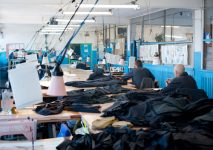The Prison Industrial Complex – Exerting Social Control and Producing Cheap Labour

Prison industrial complex (PIC) is a term used to describe systems where the government uses incarceration as a way to deal with people labelled as undesirable, while helping private industry to turn a profit.
Such models are heavily focused on social control – from pervasive surveillance to strict law enforcement and imprisonment of individuals for conduct that is classified as anti-social; including non-violent crimes like drug offences.
While the PIC provides a mechanism for governments to identify ‘common enemies’ and attract favour from big business by providing cheap prison labour, the model can work against the interests of disempowered people and broader society by placing little emphasis on diversionary programs and rehabilitation, and thereby resulting in high recidivism (reoffending) rates.
Offenders generating profit
Indeed, high rates of reoffending keep the wheels of the PIC turning. This model relies heavily on serial reoffenders – many of whom are poor, people of colour, LGBTI people, immigrants and youth – to justify the proliferation of vast networks of correctional facilities.
The common perception that most prisoners are dangerous to society is erroneous. Indeed, research has consistently found that most people who end up behind bars are there for crimes that do not involve violence.
Rather, society is placing large numbers of people in prison for non-violent acts, such as drug offences, rather than for physically harming others. A 1998 US study found that 77 percent of inmates were not there for violent crimes.
These incarcerated non-violent offenders are, in turn, being paid next to nothing for work that generates enormous profits for private corporations.
But in the eyes of many, the companies that profit from the PIC are committing no transgressions whatsoever. And many believe that those who end up in prison have an obligation to ‘earn their keep’ by working for a pittance.
Angela Davis
One of the most prominent critics of the PIC is Angela Davis: the American countercultural activist, academic and author, who has been at the forefront of political activism since the 1960s.
Ms Davis used to be a leader of the United States Communist Party. At one stage, California governor Ronald Reagan tried to ban her from teaching at the state’s tertiary institutions, because of her counter-institutional views.
Ms Davis was even on the FBI’s ten most wanted list, after a gun used to kill a judge was allegedly registered in her name.
If only that magic did exist
Back in 1998, Ms Davis explained that prisons “perform a feat of magic”, as the majority of voters believe they “disappear problems”. However, Davis pointed out that what they really do is “disappear human beings.”
As she further explained, “the practice of disappearing vast numbers of people from poor, immigrant, and racially marginalized communities has literally become big business.”
In the late 1990s in the United States, two million people were incarcerated and more than 70 percent were people of colour. The fastest growing group of inmates was black women, and Native Americans comprised the largest group per capita.
Australian colour lines
As of June 30, 2015, Aboriginal and Torres Strait Islander people comprised 9,885 of the 35,845 people incarcerated in Australia. While Australia’s first people constitute just 3 percent of the nation’s total population, they make up 27.5 percent of the prison population.
Indigenous people are fourteen times more likely to be imprisoned than the rest of the population.
And so it goes in Australia, just like in the States, that poorer people of colour are being incarcerated at a disproportionate rate.
“Coloured bodies constitute the main human raw material in this vast experiment to disappear the major social problems of our time,” Ms Davis wrote in Color Lines, adding that what’s revealed is racism and class bias, latent within the capitalist system.
“The prison industrial system materially and morally impoverishes its inhabitants,” she concluded.
So there’s the critique. What’s the alternative?
The most obvious alternative is to stop the wholesale incarceration of people for non-violent crimes, and to focus on preventative and diversionary programs, including those which address underlying issues.
For those who are imprisoned, the focus should be on rehabilitation rather than punishment.
It’s like Debbie Kilroy, chief executive of Sisters Inside told Sydney Criminal Lawyers® a few weeks back, if you’re going to build more prisons, you’ll still have an overcrowding issue. This is because the result of building more correctional facilities is that you need to convict more people in order to fill them.
Many companies rely on prisoners to produce cheap goods and maximise profits, or if they’re like Sodexo, the company that runs the new Melaleuca Remand and Reintegration Facility in WA, to keep themselves financially viable.
The government’s ‘solution’ to Sodexo’s obvious interest in keeping inmates imprisoned for longer, and having them reoffend, is incentive based – for each inmate that doesn’t return to prison within 24 months, the company receives a $15,000 bonus.
Prevention and diversion
Prison abolitionists posit that there are ways to keep large numbers of people from being sent to prison in the first place, and this primarily involves shifting the focus away from punitive measures and towards preventative and diversionary programs.
Indeed, prevention initiatives such as justice reinvestment have not only proven to be impressively successful in addressing underlying issues that lead to crime – such as poverty, lack of housing and employment opportunities, and drug, alcohol and mental health issues – they are extremely cost effective, with every dollar spent saving the community several dollars in enforcement and incarceration costs.
Similarly, diversionary programs such as MERIT, Drug Court and Forum Sentencing which steer offenders away from the criminal justice system and towards getting the help they need have consistently achieved better outcomes than imprisonment when it comes to reoffending rates – often helping offenders to break the cycle of crime.
But with governments embracing punitive models of criminal justice, there may be a long way to go before the PIC becomes a thing of the past.








